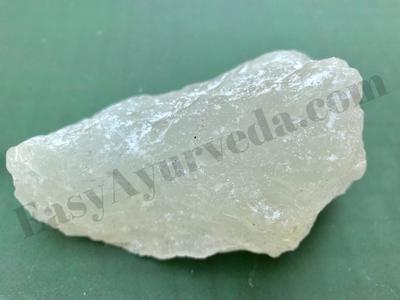Sphatika (Alum): Synonyms, Types, Qualities, Shodhana, Marana, Dosage
Sphatika is available in two forms. White and reddish white. In ancient times, it was available in Saurashtra region. So the name Sourashtri. Nowadays, white varieties are used. It is found in small to big pieces. It is madhura / Amla in taste and is soluble in water. It contains 24 parts of water.

Table of Contents
Synonyms
Sphatika, Sphutika, Kankshi, Sourashtri, Shubhra, Phatika, Rangada, Tuvari.
Availability
Gujarat, Punjab, Bihar, Uttar Pradesh, Maharashtra, Goa.
Types
1. Phataki 2. Phullika.
Phataki is yellowish, heavy, unctuous and anti-toxic.
Phullika is white, light and unctuous.
Qualities
Amla – sour,
madhura – sweet,
kashaya – astringent,
Vranaropaka – wound healing,
Grahi – absorbent,
Sankochaka – constricting,
raktasthambhaka – hemostatic,
keshya – good for the hairs and
useful in Shwitra – leucoderma and
Mukharogas – diseases of mouth.
Shodhana
- Alum is dipped in kanji for three days.
2. Alum is powdered and kept on a flat pan, and heated till it loses all the watery portion and swells. It is the purified form of Sphatika.
Marana
Sphatika is given Bhavana with Bhedamutra and cakes are prepared and gajaputa heat is given to get its bhasma.
Read more about Sphatika Bhasma here
Uses
Bhasma is useful in Parshwashula (pain in flanks), Pneumonia, Katishoola, Dry cough, Rajayakshma (consumption), haematemesis, menorrhagia, leucoderma, Visarpa (herpes) etc.
It is also used externally to check bleeding and also in eye dosage forms.
Dosage
1 – 4 ratti (125 mg to 500 mg) per day in divided doses








